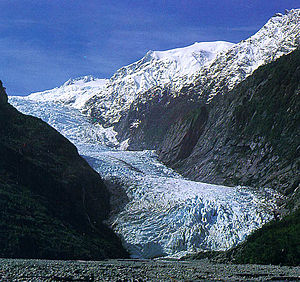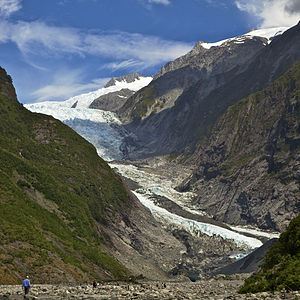Franz Josef Glacier
| Franz Josef Glacier | ||
|---|---|---|
|
Franz Josef Glacier in 2001 |
||
| location | New Zealand , South Island | |
| Mountains | New Zealand Alps | |
| Type | Valley glacier | |
| length | 10.25 km | |
| surface | 32.59 km² | |
| Exposure | northwest | |
| Altitude range | 2955 m - 425 m | |
| Coordinates | 43 ° 30 ′ S , 170 ° 13 ′ E | |
|
|
||
| drainage | Waiho River, Tasman Sea | |
|
Franz Josef Glacier in 2011 |
||
The Franz Josef Glacier (English: Franz Josef Glacier , Māori: Kā Roimata o Hine Hukatere ) is an approximately 10 km long glacier in Westland National Park on the South Island of New Zealand . It is located on the west side of the New Zealand Alps . Like its southern neighbor, the Fox Glacier , it flows down the steep western flank of this mountain range from its flatter nutrient area . It drains into the Tasman Sea via the Waiho River .
In 1852 Leonard Harper named Franz Josef and Fox Glaciers after Victoria and Albert , the English royal couple at the time. Since he did not make this known officially, he was named after Franz Joseph I of Austria by the German explorer Julius von Haast in 1865 .
About 150,000 years ago, the glacier was so large that it completely enclosed Aoraki / Mount Cook and the surrounding mountains. The repeated melting and regrowth of the glacier had the consequence that several chains of hills formed in the valley towards the sea, which were formed from the moraine rock that the glacier pushed in front of it. The Franz Josef Glacier is a temperate glacier and flows about half a meter per day. An airplane that crashed over the glacier was released from the ice after a comparatively short seven years. The high flow speed is also due to the large amount of water that flows over waterfalls to the right and left of the ice under the glacier and thus serves as a kind of lubricant.
The glacier was created due to the special location of the tectonic plates on which Aoraki / Mount Cook and its surrounding mountains are located. Two continental plates meet on the west coast of New Zealand and have formed a very high mountain massif directly on the coast. The large amount of precipitation results from the fact that warm and humid air is brought in via the Tasman Sea and cools down strongly and rains out on the high massif. As a result, there is about ten times more precipitation on the west side of the South Island of New Zealand than on the east coast.
Just like the Fox Glacier , the Franz Josef Glacier was once so big that it calved straight into the sea . Even today it is still, together with the Fox Glacier, one of the lowest glaciers of medium width above sea level (approx. 400 m). After the glacier had shrunk significantly between the end of the 19th century and 1982 and had lost more than 3 km in length, it began to grow again by about 1 km since 1982. Since 1999 the trend has reversed again and the glacier has lost mass again.
This makes the Franz Josef Glacier one of the few large glaciers that have so far not been so severely affected by global glacier melt . By the end of the century, however, it is expected that the glacier will lose another 5 km in length and around 38% of its mass.
Web links
- Glacial find pours cold water on world theory , NZ Herald (New Zealand), June 30, 2008
Individual evidence
- ^ A b c World Glacier Monitoring Service (WGMS): Fluctuations of Glaciers 2005–2010 (Vol. X). Zurich 2012 ( online ( memento of the original from March 5, 2014 in the Internet Archive ) Info: The archive link has been inserted automatically and has not yet been checked. Please check the original and archive link according to the instructions and then remove this note .; PDF; 5.0 MB )
- ↑ glaciercountry.co.nz Franz-Josef-Glacier ( Memento of the original from June 25, 2013 in the Internet Archive ) Info: The archive link was inserted automatically and has not yet been checked. Please check the original and archive link according to the instructions and then remove this notice.
- ^ BL Hooker, BB Fitzharris: The correlation between climatic parameters and the retreat and advance of Franz Josef Glacier, New Zealand. In: Global and Planetary Change. Vol. 22, No. 1/4, 1999, ISSN 0921-8181 , pp. 39-48, doi : 10.1016 / S0921-8181 (99) 00023-5
- ^ Brian Anderson, Wendy Lawson, Ian Owens: Response of Franz Josef Glacier Ka Roimata o Hine Hukatere to climate change. In: Global and Planetary Change. Vol. 63, No. 1, 2008, pp. 23-30, doi : 10.1016 / j.gloplacha.2008.04.003




